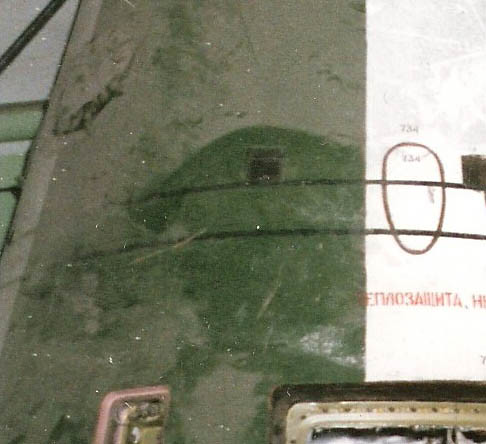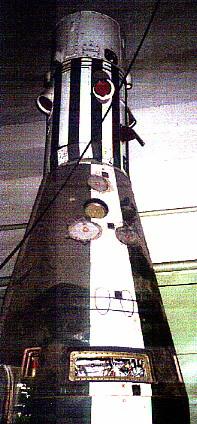TKS (docked to Salyut 7):
Characteristics:
Crew Size: 3. Habitable Volume: 37.00 m3. RCS Coarse No x Thrust: 20 x 390 N. Spacecraft delta v: 700 m/s (2,290 ft/sec). Electric System: 2.40 average kW.
AKA: FGB Functional / Cargo Block.
Gross mass: 13,260 kg (29,230 lb).
Unfuelled mass: 9,438 kg (20,807 lb).
Payload: 4,528 kg (9,982 lb).
Height: 13.87 m (45.50 ft).
Diameter: 2.90 m (9.50 ft).
Thrust: 7.84 kN (1,763 lbf).
Specific impulse: 291 s.
TKS BSO
The BSO was equipped with the retro-rocket for deorbit of the VA capsule following separation from the space station. Deorbit Block. It also provided the additional battery power, orientation rockets, and radio equipment that gave the VA a 31 hour autonomous flight duration after separation from the station.
Characteristics:
Spacecraft delta v: 100 m/s (320 ft/sec).
AKA: Bloka Skhoda s Orbiti.
Gross mass: 450 kg (990 lb).
TKS SAS
The SAS system abort system for the VA separated the capsule with 15 G's of acceleration from the booster in case of a malfunction and soft landed the capsule 1.0-1.5 km from the launch pad. When the 'Abort' command was sent, the 86 metric ton thrust motor of the ADU pulled the VA capsule away from the pad. 10 seconds from the abort command the ADU/TUD/NO separated and the landing systems went into operation. The braking parachute deployed for seven seconds, followed by the main chute with 1770 square meters of area. The capsule made a soft landing 2 km away. The SAS was jettisoned after the Proton booster had cleared the atmosphere.
Characteristics:
Spacecraft delta v: 140 m/s (450 ft/sec).
AKA: Sistem avariyovo spaceniya.
Gross mass: 2,950 kg (6,500 lb).
Thrust: 843.00 kN (189,513 lbf).
TKS VA
The VA was capable of 31 hours of autonomous flight after separation from the FGB. The crew of three were provided with seats with customized form-fitting liners facing a control panel similar to that used in Soyuz T. Access to the FGB on the pad was through a square hatch in the side of the capsule. This could also be used to conduct EVA's in orbit, with the VA acting as an air lock for the FGB. Access to the FGB was via a hatch in the heat shield below the middle seat. With the crew, 50 kg of payload could be returned. Without the crew 500 kg of payload could be returned. Total internal volume was 8.37 m3. Retrofire was initiated by the BSO block on the nose of the VA. The VA capsule had a hypersonic lift to drag ratio of 0.25. This allowed the BSU-V manned capsule guidance system to maneuver the spacecraft to its landing point using the optimum path for minimal heating and G-forces.
Characteristics:
Crew Size: 3. Habitable Volume: 4.56 m3. Crew: 255 kg (562 lb). Miscellaneous Contingency: 50 kg (110 lb).
AKA: Vozvrashchaemiy apparat.
Gross mass: 3,800 kg (8,300 lb).
Payload: 1,880 kg (4,140 lb).
Height: 3.64 m (11.94 ft).
Diameter: 2.79 m (9.15 ft).
First Launch: 1976.12.15.
Last Launch: 1979.05.22.
Number: 9 .




 to this forum! Your participation will be highly appreciated!
to this forum! Your participation will be highly appreciated!

